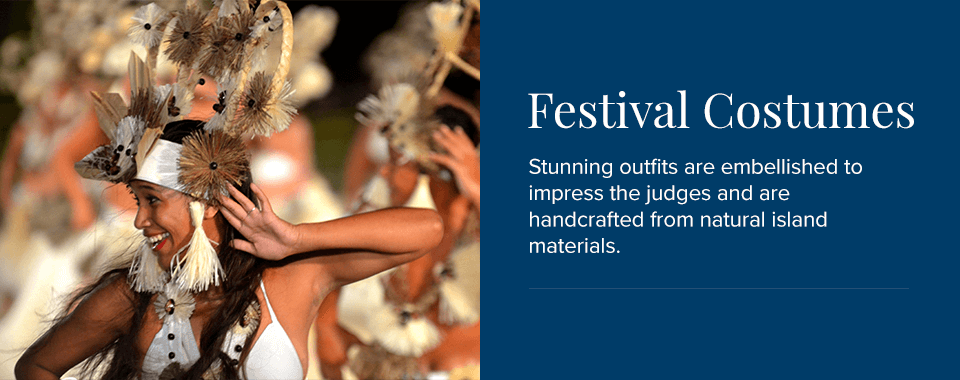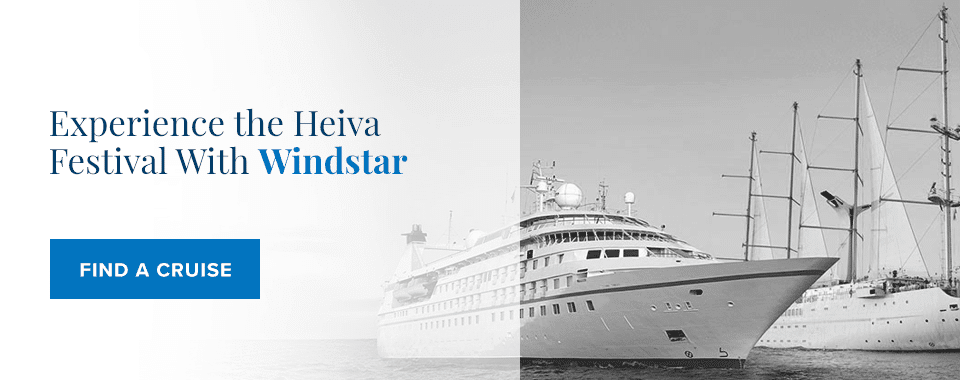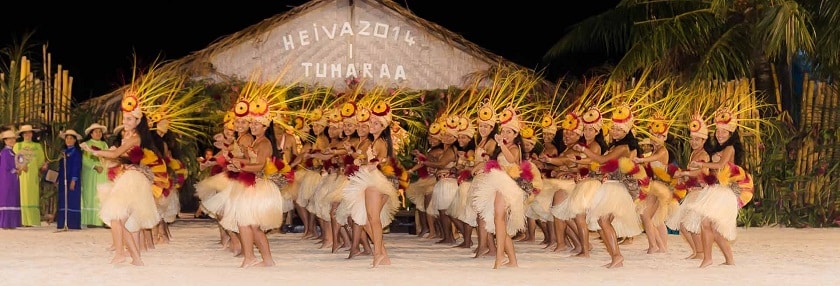
The Heiva is one of the oldest festivals in the world, held in one of the most beautiful places on earth. You may not have heard of it, but it is one of the greatest cultural events in Oceania. The Heiva is the best way to experience the rich culture of the ancient Polynesians — it is no ordinary celebration but an explosion of color and an emblem of cultural pride. It is a special occasion for a group of people who were once shunned for expressing their heritage.
We present to you a breakdown of what this celebration is about and a look into the inner workings of the extraordinary Heiva Festival.
In This Article
- What Does Heiva Mean?
- What Is the Heiva Festival About?
- When Is the Heiva Festival?
- Where Is the Heiva Festival Celebrated?
- The Origins of the Heiva
- Tips for Experiencing the Heiva
- Experience the Heiva Festival With Windstar Cruises
What Does Heiva Mean?
Also known as the Polynesian Celebration of Life, the Heiva Festival — pronounced “hay-vuh” — immerses the beautiful islands of French Polynesia in a flurry of color as locals honor their ancestral heritage. The meaning of “Heiva” is a combination of the words “hei” and “va,” meaning “to gather” and “communal places,” respectively.
All five French Polynesian archipelagos commemorate the Heiva with unique festivities that highlight their local traditions. The primary song and dance competitions are held in Place To’atā in Papeete, the capital city of Tahiti, where the Heiva Festival celebrations are most prominent.
What Is the Heiva Festival About?
The Heiva is a vibrant festival all about celebrating Polynesian culture and heritage. It is a remarkably unique event that must be experienced firsthand. Plus, it’s held in paradise! The Heiva Festival emphasizes old Polynesian tradition, culture and legacy as various forms of French Polynesian dance, music, art and crafts are presented. Dance groups sport a variety of colorful, traditional and themed outfits. There are plenty of sights to see and activities to partake in on all the islands.
Various competitions are also held during the Heiva Festival, drawing thousands of athletes, singers, dancers, musicians and artists from all five archipelagos who compete in both individual and team events for bragging rights. Competitions include sports games, canoe races, palm climbing, coconut opening and beauty contests.
Festival Music
Each performance group is accompanied by a large orchestra comprising local instruments, including the ukulele, the vivo — a bamboo nasal flute — and the pū, which are conch shells. The festival also hosts a prominent and intense singing competition in the Tahitian language, Reo Ma’Ohi, which is sung a capella.
Festival Costumes

The costumes of the Heiva are one of the main highlights of the festival. The Heiva costumes take spectators on a journey through French Polynesian history. Stunning outfits are embellished to impress the judges and are handcrafted from natural island materials. The traditional tribal attire is created from plants, seeds, roots, feathers and various indigenous flowers. Women, for instance, frequently wear coconut bras, beautiful flower necklaces and headpieces made of grass.
When Is the Heiva Festival?
While there are no official dates for the Heiva Festival, celebrations usually commence in the first week of July and last the whole month. Dancers spend up to six months training and handcrafting their costumes. The dancer’s choreography is based on historical and cultural themes. The first Heiva Festival was held in 1881, making the festival one of the oldest in the world.
Where Is the Heiva Festival Celebrated?
Festivities are held throughout all five archipelagos of French Polynesia. Each island hosts its own activities and performances, honoring the island’s unique culture. The principal Heiva celebrations are typically held on the main island, Tahiti, in Papeete, the capital city of French Polynesia. Most activities occur at the square of Vaitape at Place Tu Vavau. The festival’s primary song and dance competitions are held in Place To’atā, an outdoor amphitheater in Papeete.
The Origins of the Heiva
The Heiva Festival’s roots began when the first Europeans arrived on the Tahitian islands. The people are described in early oral and written descriptions as being exceedingly carefree, and that singing, dancing and music were always an essential part of daily life in French Polynesia. After the first explorers, the European Protestant missionaries who came to the islands in the 19th century strongly disapproved of several Polynesian customs, including dances and traditional attire.
The colonial government banned many ancient Tahitian art forms, including dancing, music, art, costume-making, tattooing and stone temples. Tahitian culture has long placed a high value on the arts, music and dancing, all of which were almost entirely eradicated by colonialism. However, despite the significant risks, many families continued to practice and pass down these Tahitian customs through the centuries.
As Catholics, the French allowed Tahitians to celebrate their culture through music, dance and sporting competitions when the Islands fell under French rule. The new law was officially enacted on July 14, 1881, which gave rise to the Tiurai celebration, an early iteration of the Heiva Festival. As Tahitians achieved greater autonomy, pride in their traditional culture was restored and customs embraced. The Tirurai festival was succeeded by the Heiva. The Heiva Festival is essentially a Tahitian revival of culture that colonialism long suppressed.
Tips for Experiencing the Heiva
Celebrations are held across all five archipelagos of French Polynesia during the Heiva Festival. The main events are held across Tahiti but the other islands also have exciting activities that highlight traditional Polynesian culture. It’s a good idea to have a list of the principal Heiva celebrations to ensure that you don’t miss out on any. Here are three main Heiva events to add to your itinerary:
1. Fire Walking Ceremony
The festival begins with a fire-walking ceremony that serves as a prelude to the opening ceremony, much like the Olympic torch tradition. Brave participants in this Heiva fire ceremony cross incredibly hot rocks from local beaches.
2. Heiva Art Ceremony
During the Heiva, there is an art festival named “Heiva of the Artisans,” where artists from all five archipelagos present their unique creations. Each island group draws inspiration from its own distinct history and aesthetic. The primary Heiva event is held simultaneously with “Heiva of the Artisans.” Local artisans create impressive traditional artwork from natural materials, including shells, pearls, pandanus and coral. Also on display is the Polynesian tattooing art known as tatau.
3. Heiva Sports Competitions
Last but not least, the festival includes sporting events held at several locations in Papeete, including Pointe Venus, the Paofai Gardens in Papeete, the Museum of Tahiti and the Islands lawns in Punaauia. Typically, Pira’e and the southern part of the island are the locations of the canoe races.
The Heiva Sports Competition, often known as the Polynesian Olympics, focuses on showcasing physical prowess. The gold medal winner will be dubbed “Mr. Tahiti” and enjoy widespread worship. The Heiva sporting events are held per Tahitian customs. Sports competitions include horse racing, javelin throwing, outrigger canoeing, “coconutting” — climbing, picking and cracking 10 coconuts in record time — stone hauling and spear throwing.
Experience the Heiva Festival With Windstar Cruises

What better way to explore the majestic islands of French Polynesia than on an elegant yacht? We’ve spent more than 35 years cruising the archipelagos and know the best sights to see. Our travel advisors can assist you with your itinerary and answer any questions about our cruises, excursions and other details. Call us at 1-844-884-4649 or fill out our form to request a call!



















































